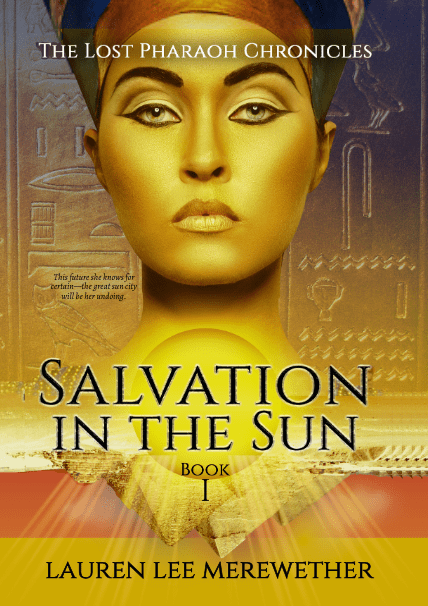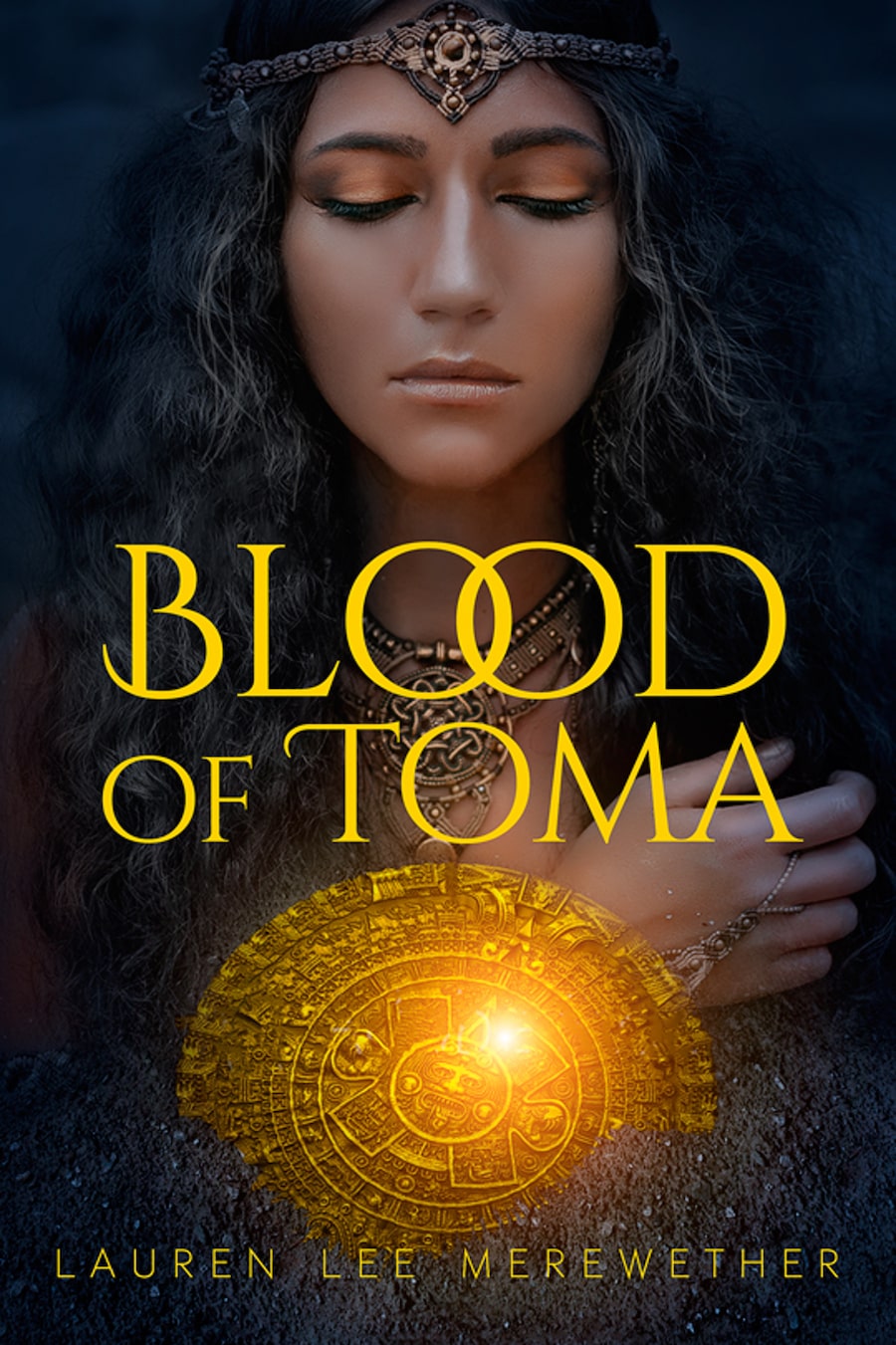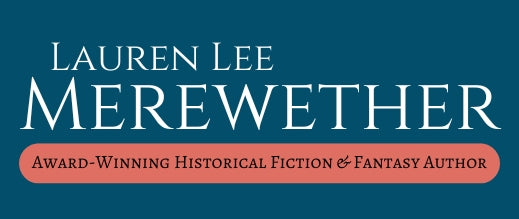BEHIND THE SCENES
A place where you can:
Follow Lauren's Writing Progress.
Read from Lauren about her mindset and techniques as she wrote each of her series starters.
Find a non-inclusive list of web sources Lauren used in her research.
Lauren's Writing Progress
Behind the Books
Take a peek at the production of Blood of Toma, Salvation in the Sun, The Curse of Beauty, and Warrior King (coming soon).


Behind the Book: The Curse of Beauty
My early readers, beta readers, and some members of my launch team have asked me how I came up with such an imaginative story to have inspired the Medusa myth. So here in a Behind the Scenes moment, I will give you the answer.
I knew I wanted to write a story of what could have actually happened in history to inspire the myths spanning the generations of Greek titans and gods. The myths begin with Uranus and Gaia birthing the titans. Two couples are at the forefront of this series: Oceanus and Tethys and Ceto and Phorchys. Oceanus and Tethys beget gods/demi-gods intertwined with the children of Cronus and Rhea and we get your monsters/creatures from Ceto and Phorchys. So with that in mind, as I was trying to figure out when in history these events might have taken place, I realized very early on in the generational hierarchy, some of these people (like half of the generations between Oceanus and Perseus) were Egyptian queens and kings.
So when were Ancient Greeks crowned as Egyptian kings prior to 800 BC which is when the Greek myths were first recorded by Hesiod? The only time, that I'm aware of, in Egyptian history before this time where Egypt was ruled by someone other than Egyptians was the Second Intermediate Period, whom the Egyptians called the Hekka Khasut (Hyksos), and if Mycenae was really founded by a man named Perseus in 1350 BC (which would be the correct dating if the Battle of Troy happened around 1200 BC per the archaeology reports) then counting back the generations from Perseus to Oceanus would put Oceanus around 1650 BC (which is right around the start of the Mycenaean age). Which by the way, also fits in with his mythological granddaughter becoming queen of Egypt around the first decades of the Second Intermediate Period of Ancient Egypt. At this point, my mind was blown.
But I wanted to write a story about Medusa…so how do I take a snake headed, killer-looking monstrous creature and make her a real person? And during this ancient time?
So I started researching the inhabitants of Greece at that time and the influences that academic books said they had found at the end of the Middle Helladic era in their excavations. Minoan influences (pre-Mycenaean) were prevalent. I researched hypothesized migration patterns of people of how Greece became populated. I decided that I would take the hypothesis that the Minoans might have been a matriarchal society to heart. Since they have a goddess (or two) that is a snake goddess or a Mother Goddess and the Thracians also had a Mother Goddess as well as the original inhabitants from 3000 BC, then I would make the Peloponnese inhabitants the same. However, the Mycenaeans were a very patriarchal society where war and ferocity was embedded in their daily life with a supreme god not goddess. Their entire societal construct seemed to be based on a military hierarchy.
Anyway, taking all of that in, I began writing The Curse of Beauty. You’ll have to read the “A Look into the Past” section in the back of the book for more reasons why and how I wrote the story in the way that I did because I hate spoilers and I don't want to write any here.
Since I am a family saga author, I also like connecting books. At least books that flow into each other even if they stand alone. It makes me feel like an insider when I know something another reader may not know yet muahaha. That is one reason why I like to write prequels, and for this series, uncover the origins of the matriarch of Greek Mythology, Tethys, and how her name traveled through time to become that of legend in The Curse of Revenge. Its ebook version is free to my newsletter subscribers, and the paperback is US$4.99 if you want that action packed story.
One other note: I had a huge epiphany and decided Ancient Legends series is going to connect with my other new series Egypt’s Golden Age Chronicles which will connect with The Lost Pharaoh Chronicles!
Woo Hoo! Connections all around.
Ancient Legends will continue until the emergence of the Classical Greece age and end with a story that inspired the myth of King Midas and the Golden Touch! So much more to come, and I’m super excited. My creative mind is burning to write all of my ideas down and I hope you love these stories as much as me!

Behind the Book: Salvation in the Sun
I have been getting some questions about who was my favorite character in Salvation in the Sun. So, here is my answer in a true Behind the Scenes moment!
My Favorite Character is KIYA!
The most loyal friend, pure and innocent until the end.
Assumed to be the historical Mitanni bride named Tadukhipa and given the pet name "Kiya" by Akhenaten, this young woman struck a cord of admiration in me. So much so, I wrote her origin story as an offshoot prequel to Salvation in the Sun which then prompted the entire prequel collection!
I needed to answer the questions about her character: What made her be so loyal? Why was she so desperate for friendship? Why did she find solace in painting?
Read The Mitanni Princess to join me on this long-forgotten journey deep into the Mitanni Empire where a princess battles her father for a chance to live her own life. It's a FREE download with email sign-up!
There is a free bonus ending hidden on my website as an Easter egg. Can you find it?
Be warned: There are spoilers in the bonus ending if you have not read Salvation in the Sun.
Here are some other behind the scenes tidbits of Salvation in the Sun (for a full detailed look of what really happened or what we know happened during this time period and more cool facts about Ancient Egypt, read the A Look into the Past section at the end of each book of the series):
- Aitye is a fictional character. Aitye means 'Gift' and has origins from Arabia.
- Nefertiti's mother is unknown. Temehu is a name I gave her. Temehu is actually what the Ancient Egyptians called the Libyans. There is speculation Nefertiti was not 100% Egyptian, so this is the inspiration behind Nefertiti's mother's name.
- Malkata was the gigantic palace of King Amenhotep III and was the largest known palace of any ancient King and even included a lake!
- Jabari is another fictional character in Salvation in the Sun. I liked his name because the meaning of the name Jabari is 'Brave'. Originally, General Paaten was General Jabari in my rough draft, but I decided to use the real general instead - to better keep with history, of course.
General Paaten is actually Paatenemheb ("The Aten is in festival") who was commander in chief of the army of Akhenaten. He is sometimes liked to the same person as Horemheb.
- Neferneferuaten Tasherit, the fourth daughter of Nefertiti was named after Nefertiti herself! Tasherit means 'the younger' or in today's terms ' junior'.
Additionally to get some more insight on the characters, family tree, map of the region, why I chose to end Book I were I did, my decisions behind the cover design and more, check out the free Reader's Guide to Salvation in the Sun.
Here is an example of what you can find in the Reader's Guide:
In Salvation in the Sun, Kiya is depicted painting with a reed brush, a papyrus canvas and "paints." This had caused some stir with my hard core Ancient Egyptian fan readers, and I had a few people email me telling me Ancient Egyptians did not paint...but from my research, I found that they might have. I also found conflicting information on if painting for leisure was restricted to the upper class and/or super wealthy elite, or if painting was solely a religious or pharaonic activity.
Archaeologists have found several paint boxes containing pigments that date back to the 18th-20th Dynasties which is when The Lost Pharaoh Chronicles takes place. Click here to go to an instagram post from the Cleveland Museum of Art displaying the paint box that belonged to vizier Amenemope of Amenhotep II (Amenhotep III's grandfather). If the Vizier, who I could not verify was also a priest, had a paint box, I felt painting then could have been done for leisure, and thought it was acceptable for Kiya to do so in the story. Additionally, click here to go to the RISD Museum website regarding an Ancient Egyptian paint box dated to King Tut, about 10 years after Salvation in the Sun.
If you thought these Behind the Scenes tidbits were cool - please help me spread the word about The Lost Pharaoh Chronicles on your social media accounts and leave a review on Amazon and Goodreads!
Many Thanks and Happy Reading!
Lauren

Behind the Book: Blood of Toma
I always get questions about how I choose the names for my characters.
So, here are my answers in a true Behind the Scenes moment!
Naming Characters
For the fictional characters, Azti, Zolin, Tomantzin, Meztli, etc. in Blood of Toma, I went to several websites like www.BehindtheName.com and www.MexicaTribe.com and did a blanket search on names with a certain ethnic origin, so in this case, Aztec or Nahuatl. Nahuatl is the name of the language the Aztecs spoke. I found names ending with the "tzin" (pronounced simpleton style "seen") meant they were honored names signifying fondness, respect, or reverence but could mean a parent or an original if speaking about places instead of people.
FUN FACT: During this search I also found that the Aztecs did not refer to themselves as the Aztecs but rather as the Mexica during this time period - The name Mexica actually came out of a civil war a few centuries before the Conquistadors arrived. They called themselves the Aztecs (people from Aztlan) until the civil war sometime in the 1300/1400s. Mexica means "sons of Mexi" or Huitzilopochtli (the sun god, god of war).
I scrolled through countless names looking at meanings and names after certain gods/goddesses. I had an idea of the name of the book - Blood of Someone - and I wanted the name for the main character to flow with it. I found Tonantzin which was a male name after the Mother Goddess Earth and should only be used as a last name. (Author Confession: I really liked that name so I changed the "n" to a "m" and hoped it would pass for a female name.) The name Tomantzin was too long for the title but I loved her (his) name meant Honored Mother since the character was the New Fire Sacrifice (Author Confession: which was also usually a man not a woman). I gave Tomantzin the nickname Toma and presto! Blood of Toma became the title and Toma was the name her loved ones called her.
FUN FACT: Here are some guides for pronunciation:
"...TL" at the end of a word - the "L" is silent
"HU" - sounds like a "W"
"LL" - sounds like the English "LL"
"X" - sounds like "SH"
For the Conquistadors, I searched for names with origins in Spain. For Arrio's name, I knew I wanted it to have the lovely rolled "r" sound, and so I narrowed it down to names containing the double "r" and finally picked Arrio. I liked the way it rolled off the tongue :)
For the real historical figures during the time period such as Ixtlilxochitl II, Moctezuma/Montezuma II, Chaucomauc, Cacama(tzin) and Hernan Cortes, I simply googled their names and all the different spellings and picked one I liked with the exception of Chaucomauc - his real name was Tetlepanquetzal. I had no idea how to pronounce that name and could not find a pronunciation guide for that name, so I went with Chaucomauc instead which is a variation of the name of the temporary king, Cuauhtemoc. Cuauhtemoc stepped up when Moctezuma II was killed and ruled until 1521 when the Conquistadors finally overthrew Tenochtitlan.
For more cool facts behind this time period and the book in general, sign up HERE to get an email once a month for 12 months with a freebie linked. The first one is a map of the region the story takes place in a downloadable .pdf.
If you thought this Behind the Scenes tidbit was cool - please help me spread the word about Blood of Toma on your social media accounts and leave a review on Amazon and Goodreads.
Many Thanks and Happy Reading!
Lauren
Research Sources
A Non-Inclusive List of Lauren's Reference Material for your Curiosity
Egypt (Kemet)
https://www.jstor.org/stable/545782?seq=1
https://www.jstor.org/stable/30137849?seq=1
https://www.jstor.org/stable/3821718?read-now=1&seq=1
https://www.jstor.org/stable/10.1086/519030?read-now=1&seq=1
http://www.touregypt.net/featurestories/navy.htm
http://virtualkemet.com/perankh/namesmale2.htm#y
https://seshkemet.weebly.com/egyptian-sayings.html
https://www.newworldencyclopedia.org/entry/Ebers_Papyrus
https://www.worldhistory.org/article/1079/trade-in-ancient-egypt/
https://history.stackexchange.com/questions/49550/how-did-people-in-the-desert-stay-cool-in-the-past
https://www.worldhistory.org/article/1035/weapons-in-ancient-egypt/
https://www.worldhistory.org/Egyptian_Warfare/
https://en.wikipedia.org/wiki/Ancient_Egyptian_cuisine
https://www.perankhgroup.com/Food%20and%20Drinks%20in%20Ancient%20Egypt.htm
https://upload.wikimedia.org/wikipedia/commons/4/49/Ancient_Egypt_map-hiero.svg
https://www.hierarchystructure.com/ancient-egyptian-military-hierarchy/
https://www.conazarene.org/hp_wordpress/wp-content/uploads/2015/10/Bible-Timeline.pdf
https://sites.google.com/site/historyofancientegypt/18th-dynasty
https://www.britannica.com/topic/Hapiru
https://redseaexodus.files.wordpress.com/2014/02/historicalalignmenttimelinenoahtochrist4-1.png
http://www.20000-names.com/female_egyptian_names_03.htm
https://www.world-archaeology.com/features/gurob-unlocking-a-royal-harem/
https://www.spurlock.illinois.edu/exhibits/online/mummification/materials.html
http://www.peiraeuspubliclibrary.com/Kitaneja/KhentAbt/Hutwaret.html
https://www.nationalgeographic.com/magazine/2010/09/tut-dna/
https://www.jstor.org/stable/3855274?seq=1
https://www.fox19.com/story/11995927/king-tuts-dna-tests-reveal-a-twisted-family-tree/
https://www.scientificamerican.com/article/king-tut-dna/
https://kingtutexhibition.com/news/tutankhamuns-family-queen-tiye/
https://www.amarnaproject.com/pages/model_of_the_city/
http://www.touregypt.net/featurestories/amarna.htm
https://www.jstor.org/stable/27801605
https://www.arce.org/resource/virtual-malqata
https://mathstat.slu.edu/~bart/egyptianhtml/kings%20and%20Queens/amenhotepiii.htm
https://www.jstor.org/stable/43075469
https://www.gutenberg.org/files/26145/26145-pdf.pdf
https://ancientegyptonline.co.uk/amarnaletters/
https://archive.org/stream/TheAmarnaLetters/The%20Amarna%20Letters_djvu.txt
https://www.smithsonianmag.com/history/unearthing-egypts-greatest-temple-173651814/
https://www.ducksters.com/history/ancient_egypt/akhenaten.php
https://ancientegyptonline.co.uk/ay/
https://www.ancient-egypt-online.com/pharaoh-ay.html
https://www.worldhistory.org/Horemheb/
http://www.touregypt.net/featurestories/horemheb.htm
https://www.ucl.ac.uk/museums-static/digitalegypt/chronology/haremhab.html
https://en.wikipedia.org/wiki/Tutankhamun
jacobusvandijk.nl/docs/BACE_7.pdf
https://en-academic.com/dic.nsf/enwiki/2099032
https://ancientegyptonline.co.uk/suppiluliuma-letter/
https://www.clevelandart.org/art/1914.680
https://www.metmuseum.org/art/collection/search/544518
https://risdmuseum.org/art-design/collection/paint-box-199782
https://fathom.lib.uchicago.edu/2/21701778/
https://www.worldhistory.org/article/1026/clergy-priests--priestesses-in-ancient-egypt/
https://abutair.net/egyptian-art/
Canaan
https://www.assyrianlanguages.org/akkadian/dosearch.php?searchkey=56&language=id
https://www.jstor.org/stable/3259344?seq=2#metadata_info_tab_contents
https://www.britannica.com/place/Damascus#ref392564
https://www.britannica.com/place/Shechem-ancient-Canaanite-city
https://en.wikipedia.org/wiki/Ancient_Israelite_cuisine#Pre-Israelite
http://www.fao.org/emergencies/resources/maps/detail/en/c/889469/
https://www.jstor.org/stable/pdf/3259344.pdf?refreqid=excelsior%3A39e42c62f5ab7fc588333c3f36d843fc
https://www.everyculture.com/Sa-Th/Syria.html
https://www.jw.org/en/library/bible/nwt/appendix-b/map-conquest-promised-land/
https://en.wikipedia.org/wiki/Biridiya
http://www.peiraeuspubliclibrary.com/names/asia/canaanite.html
https://weaponsandwarfare.com/2015/08/07/the-canaanites-1500-900-b-c-e/
Thrace
https://en-academic.com/dic.nsf/enwiki/4220270
http://wiki.worldofasdar.com/index.php?title=List_of_Thracian_Personal_Names#Female
https://en.wikipedia.org/wiki/Thracian_religion
https://discovery.ucl.ac.uk/id/eprint/10042028/1/Nenova_10042028_thesis_volume1_redacted.pdf
https://www.amazon.com/Thrace-Thracians-Alexander-Fol/dp/031280220X
https://www.britannica.com/topic/Thracian
https://www.britannica.com/place/Thrace
https://www.archaeology.wiki/blog/issue/the-prehistory-of-the-district-of-western-thrace/
Greece (Attica)
https://www.sacred-texts.com/cla/mog/mog13.htm
http://www.perseus.tufts.edu/hopper/text?doc=Perseus%3Atext%3A1999.01.0130%3Acard%3D1
https://www.amazon.com/Religion-Society-Middle-Bronze-Greece-ebook/dp/B00J8LQSFS
https://en.wikipedia.org/wiki/Inachus
https://www.jstor.org/stable/25684288?read-now=1&seq=2#page_scan_tab_contents
http://www.salimbeti.com/micenei/weapons1.htm
https://en.wikipedia.org/wiki/Military_of_Mycenaean_Greece#Offensive_weapons
https://sites.dartmouth.edu/aegean-prehistory/lessons/lesson-9-narrative/
https://en.wikipedia.org/wiki/Helladic_chronology#Early_Helladic_III_(EHIII)
https://www.mapsofworld.com/world-ancient-history/helladic-civilization.html
https://www.sacred-texts.com/cla/moc/moc13.htm
https://www.worldhistory.org/Peloponnese/
https://en.wikipedia.org/wiki/Helladic_chronology
https://www.kelleyheckart.com/Pre-Hellenic_Goddesses.html
https://indo-european.info/indo-europeans-uralians/VIII_12_The_Aegean-.htm
https://en.wikipedia.org/wiki/Mycenaean_religion
https://en.wikipedia.org/wiki/Mycenaean_Greece
https://en.wikipedia.org/wiki/Mycenaean_Greek#/media/File:Homeric_Greece-en.svg
https://www.fantasynamegenerators.com/ancient-greek-names.php
https://nameberry.com/list/691/ancient-greek-names
https://commons.wikimedia.org/wiki/File:Middle_Helladic_Gold_jewellery,_AM_of_Thebes,_201133.jpg
https://en.wikipedia.org/wiki/Ancient_Greek_cuisine#Fruit_and_vegetables
https://ancient-greece.org/archaeology/dimini.html
https://en.wikipedia.org/wiki/Orchomenus_(Boeotia)
https://en.wikipedia.org/wiki/History_of_Patras
